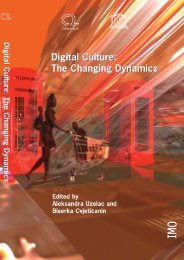free download in pdf format - Culturelink Network
free download in pdf format - Culturelink Network
free download in pdf format - Culturelink Network
You also want an ePaper? Increase the reach of your titles
YUMPU automatically turns print PDFs into web optimized ePapers that Google loves.
Cultural Identity Politics <strong>in</strong> the (Post-)Transitional Societies<br />
Th e second text that I want to look at is the essay published <strong>in</strong> Leap <strong>in</strong>to the City:<br />
Cultural Positions, Political Conditions. Seven Scenes fr om Europe, a publication on<br />
the project <strong>in</strong>itiated by the German Cultural Foundation on the cultural aff airs of<br />
seven cities of Eastern Europe <strong>in</strong> states of transition. One of the cities is Zagreb with<br />
the subject of “network<strong>in</strong>g” and “cooperation” (whereas <strong>in</strong> Ljubljana the topic was<br />
“<strong>in</strong>ternationalism” and <strong>in</strong> Prist<strong>in</strong>a “nationalism”). Th e text I am referr<strong>in</strong>g to is the essay<br />
“Recogniz<strong>in</strong>g networks” by one of the project leaders Boris Bakal, who starts his exposé<br />
by underl<strong>in</strong><strong>in</strong>g the metaphysical or Emersonian sense of understand<strong>in</strong>g the world, <strong>in</strong><br />
which “everyth<strong>in</strong>g teaches transition, transference, metamorphosis: there<strong>in</strong> is human<br />
power, <strong>in</strong> transference, not <strong>in</strong> creation; and there<strong>in</strong> is human dest<strong>in</strong>y, not <strong>in</strong> longevity,<br />
but <strong>in</strong> removal. We dive and reappear <strong>in</strong> new places” (Bakal, 2006: 413). Th is cont<strong>in</strong>uous<br />
existence, accord<strong>in</strong>g to Bakal, was part of “this region from the mid-n<strong>in</strong>eteenth century<br />
to 1946, when the new state abolished all exist<strong>in</strong>g network and civic activities or placed<br />
them under centralized control”. Under this totalitarian centralized control “<strong>in</strong>dividuals<br />
were deprived of the possibility of be<strong>in</strong>g the generator of small changes, and there is the<br />
reason for the death or disappearance of socialist models of management” (Bakal, 2006:<br />
415). As we can guess, this anti-communist discourse with very clear bourgeois ideology<br />
aims to discard the real historical collective moment (socialist self-management) <strong>in</strong><br />
order to support the charity-based non-governmental middle-class humanitarian<br />
organizations (such as Društvo čovječnosti – the Society of Humanity). Th e history of<br />
artistic collectives <strong>in</strong> Yugoslavia, especially <strong>in</strong> Croatia accord<strong>in</strong>g to Bakal, was that<br />
“European artistic context rested precisely <strong>in</strong> that their work and socialization were not<br />
determ<strong>in</strong>ed by any material preconditions but were exclusively based on volunteer<strong>in</strong>g<br />
and on spiritual strength”. Th e fact that these collectives with “spiritual strength”, such as<br />
Gorgona, Exat, Podroom, Group of Six Artists and New Tendencies, were fi nanced by<br />
the state foundations is just a momentary surprise for Bakal’s world view. Accord<strong>in</strong>g to his<br />
metaphysical approach, real creative collaboration started <strong>in</strong> the post-Tito period, where<br />
“Yugoslavia was turn<strong>in</strong>g <strong>in</strong>to an <strong>in</strong>effi cient obstacle to the <strong>in</strong>terest groups of corporate<br />
capital” (Bakal, 2006: 417), and parallel with that, for artistic collectives the awareness<br />
of their participation <strong>in</strong> this process became more obvious. One of the fi rst of these<br />
<strong>in</strong>itiatives was the project/group Katedrala (Cathedral) <strong>in</strong>itiated by Boris Bakal himself.<br />
Realized <strong>in</strong> 1987 and 1988 <strong>in</strong> Zagreb, Belgrade and Berl<strong>in</strong> this multimedia <strong>in</strong>stallation<br />
aimed at play<strong>in</strong>g the role of conscience of a scattered society by creat<strong>in</strong>g a broad network<br />
of collaborations and <strong>in</strong>terdiscipl<strong>in</strong>ary endeavours. In a very visionary manner, as<br />
Bakal claims, the visual identity of Katedrala’s catalogue from the late 1980s presents<br />
a network of spiritual antagonism by unit<strong>in</strong>g all the Zagreb churches: the demolished<br />
Jewish synagogue, the Catholic cathedral, the Orthodox Church on Preradović square<br />
and the new Zagreb mosque. Th e most important part of this vision is that Bakal and<br />
his colleagues felt that the “[socialist] society was already deeply torn <strong>in</strong> all its aspects by<br />
great antagonisms and violent economic confl icts that, <strong>in</strong> the hands of adroit politicians,<br />
were soon to be turned <strong>in</strong>to religious-nationalistic and ethnic wars” (Bakal, 2006: 416).<br />
144



